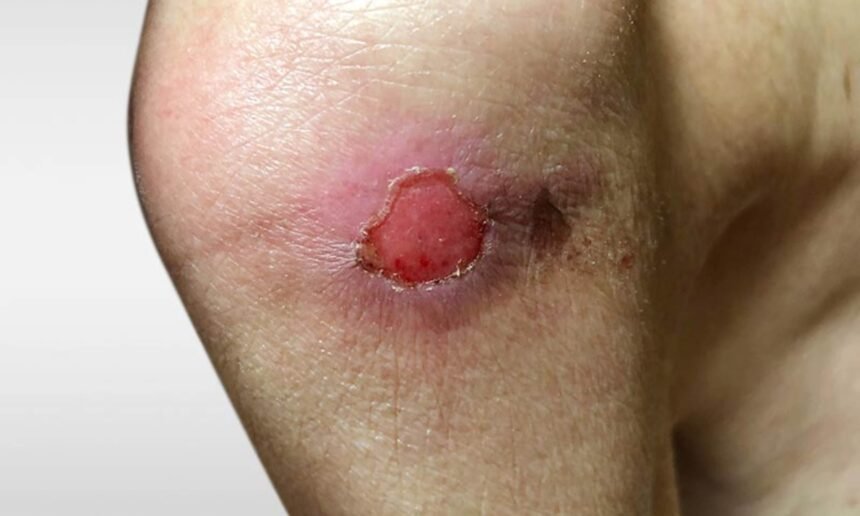Pressure ulcers, also known as bedsores or pressure sores, are localized injuries to the skin and underlying tissue caused by prolonged pressure. They commonly develop in individuals who are bedridden or have limited mobility. Understanding the causes, stages, and risk factors of pressure ulcers is essential for prevention and effective management.
Causes of Pressure Ulcers
Pressure ulcers occur due to sustained pressure on the skin, which restricts blood flow and leads to tissue damage. The primary causes include:
- Prolonged Pressure – Lying or sitting in one position for extended periods reduces blood circulation, leading to skin breakdown. Common areas affected include the heels, hips, tailbone, and elbows.
- Friction – Repeated rubbing of the skin against a surface, such as bedding or a wheelchair, can cause irritation and make the skin more susceptible to injury. This often occurs when a patient is frequently moved or repositioned without proper support.
- Shear Forces – When the skin moves in one direction while the underlying tissue moves in another, it can cause deep tissue damage. This often happens when patients slide down in a hospital bed or chair.
- Moisture – Excessive moisture from sweat, urine, or wound drainage weakens the skin barrier, increasing the risk of pressure ulcers. Incontinence-related skin damage is particularly common among bedridden patients.
- Poor Nutrition – Inadequate protein, vitamin, and mineral intake can impair wound healing and make the skin more vulnerable to damage. Malnourished patients often experience slow recovery from skin injuries.
Stages of Pressure Ulcers
Pressure ulcers are classified into four stages based on their severity:
Stage 1: Non-Blanchable Redness
- The affected skin appears red and does not turn white when pressed.
- Skin may feel warm, firm, or swollen.
- No open wounds are present at this stage.
- Early intervention can prevent further deterioration.
Stage 2: Partial-Thickness Skin Loss
- The outer layer of skin (epidermis) and part of the underlying layer (dermis) are damaged.
- The wound appears as an open sore or blister.
- Pain and tenderness may be present.
- Proper wound care at this stage can prevent infections.
Stage 3: Full-Thickness Skin Loss
- The ulcer extends through the dermis into the fatty tissue layer.
- The wound may appear as a deep crater with exposed fat.
- Dead tissue and infection risk increase significantly.
- Medical intervention is required for proper healing.
Stage 4: Full-Thickness Tissue Loss
- The ulcer extends into muscles, tendons, or even bone.
- There is a high risk of infection and complications.
- Healing at this stage is complex and often requires surgical intervention.
- Patients may experience severe pain and reduced mobility.
Risk Factors for Pressure Ulcers
Certain individuals are at a higher risk of developing pressure ulcers due to various factors:
- Immobility – Patients who are bedridden or wheelchair-bound have an increased risk of prolonged pressure on specific areas.
- Age – Older adults have thinner, more fragile skin that is more prone to breakdown.
- Chronic Illnesses – Conditions like diabetes, vascular diseases, and neurological disorders can impair circulation and wound healing.
- Malnutrition and Dehydration – Poor nutrition and insufficient fluid intake weaken the skin and slow healing.
- Incontinence – Exposure to urine and feces increases moisture and friction, leading to skin breakdown and infection risk.
- Reduced Sensation – Individuals with spinal cord injuries or neuropathy may not feel pressure or pain, leading to unnoticed wounds.
- Obesity or Underweight Conditions – Excess body weight can increase pressure on specific areas, while being underweight reduces cushioning over bony prominences.
- Smoking – Smoking reduces blood circulation, making skin more susceptible to damage and delaying wound healing.
- Medical Devices – Prolonged use of catheters, oxygen masks, or casts can apply pressure to certain areas, increasing the likelihood of ulcers.
Prevention and Management
Preventing pressure ulcers involves several proactive measures:
- Regular Repositioning – Changing position every two hours for bedridden patients and shifting weight every 15 minutes for wheelchair users can help reduce pressure buildup.
- Using Pressure-Relief Devices – Special mattresses, cushions, and padding can help distribute pressure evenly and prevent sores.
- Maintaining Good Skin Hygiene – Keeping the skin clean, dry, and moisturized can prevent breakdown and infections.
- Ensuring Proper Nutrition – A diet rich in protein, vitamins (especially vitamin C and zinc), and fluids supports skin health and wound healing.
- Monitoring High-Risk Areas – Regular skin checks can help detect early-stage ulcers and prevent them from worsening.
- Treating Existing Ulcers Promptly – Wound care treatments, including dressings, antibiotics, and debridement, can aid healing and prevent infections.
- Encouraging Movement – Even minor adjustments in bed or chair position can help alleviate pressure points and improve circulation.
Preventing pressure ulcers involves several proactive measures, including regular repositioning, using supportive surfaces, and maintaining skin hygiene.
Also Read: Essential Tips to Prevent Pressure Ulcers in Bedridden Patients
Conclusion
By understanding the causes, stages, and risk factors of pressure ulcers, caregivers and healthcare professionals can take proactive measures to reduce their occurrence and ensure better patient care. Early detection and intervention are crucial in preventing complications and improving quality of life for individuals at risk. Pressure ulcers may require advanced medical interventions in addition to basic wound care.
Also Read: Explore the best treatments for pressure ulcers, including advanced therapies


Leave a Reply